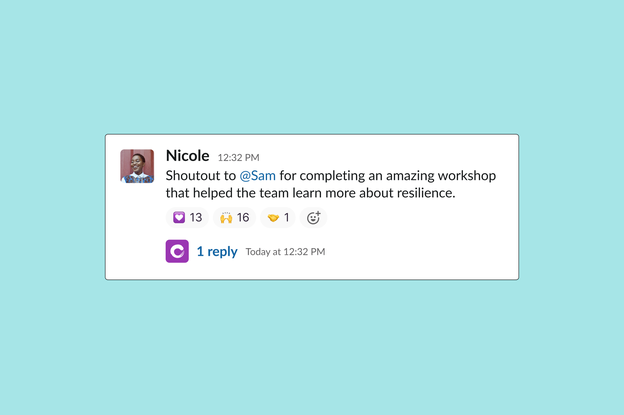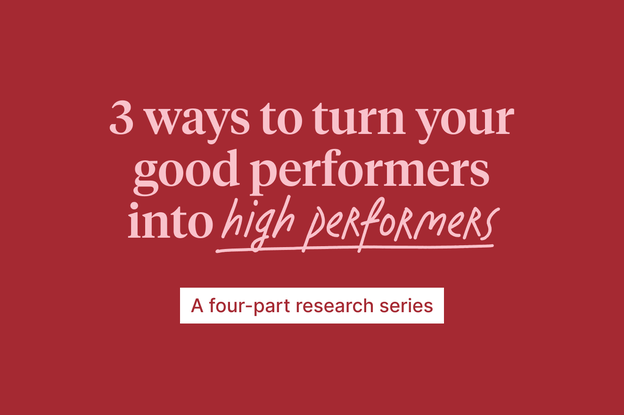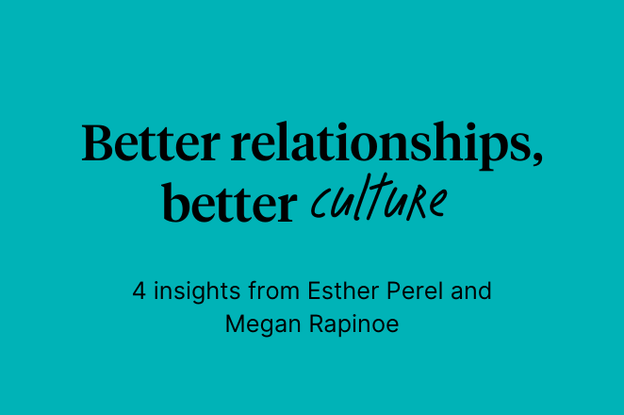How to recognize your top-performing employees

Recognition is a powerful tool for driving employee performance. When done correctly, a thoughtful recognition program can boost critical metrics such as engagement and productivity levels. In our webinar with our friends at Blueboard and Mimecast, we explored the relationship between employee recognition and performance more deeply.
In this article, we’ll examine the relationship between performance management and recognition and share tangible tips from our webinar on rewarding your top-performing employees.
The relationship between performance management and recognition
We’ve collected insights from over 6,000 customers on our platform. This data, along with peer-reviewed research, revealed that if employees aren’t engaged at work, they’re unlikely to perform to their full potential. And culture first companies know it’s not enough to simply measure engagement and assign performance ratings. We must also use this data to develop strategies that will boost engagement and, in turn, enable people to perform to the best of their abilities.
To identify what these potential strategies should focus on, we looked at thousands of data points. We discovered that rewards and recognition are among some of the strongest drivers of engagement. This was true across both industry and geography. Our research also showed that this need for recognition is especially prevalent amongst the highest-performing employees, who want to rewarded for their good performance.
Knowing this, it’s clear that recognition is one of the keys to driving important employee metrics. But how exactly do you recognize your employees effectively – especially when it comes to high-performing individuals? We dive into this question in the next section.
Tips for recognizing your high-performing employees
In the webinar, we discussed a variety of tactics that can help organizations more effectively recognize and reward their high-performing employees. Here are a few of the top tips shared by our partners:
1. Diversify your levels of recognition
There are three layers of recognition you should incorporate:
-
Day-to-day recognition.
This first layer of recognition should be accessible to all employees and usually comes in the form of verbal praise. For instance, at Culture Amp, we use “Shoutouts,” a real-time employee recognition tool that celebrates, socializes, and reinforces behaviors to intentionally shape culture and improve performance. It lives in the tools we already use, making it easy for employees to recognize a colleague for their accomplishments. -
Informal recognition.
The second layer is informal recognition, which is usually given to 25% to 30% of employees. It’s a one-off reward (i.e., a gift card) given to employees who produce particularly stellar results on a project or for another noteworthy contribution. It can also be rewarded to employees who do a great job of amplifying company values. Spot recognition is an example of informal recognition. -
Formal recognition.
Finally, the third layer is formal recognition, which is only available to the top 5% to 10% of your top-performing employees. Formal recognition can take the form of a structured sabbatical program or any other special reward, such as the experiential gifts Blueboard offers for employees who are truly at the top of their game.
Diversifying your recognition offerings with all three types described above is important. Not only does this allow everyone in the organization the opportunity to be recognized, but it also clearly distinguishes your truly top-performing employees from the rest.
-
![Screenshot of Shoutouts from Culture Amp in the flow of work]()
Article
Introducing Shoutouts: Make recognition part of your everyday culture
Learn about Shoutouts from Culture Amp, a real-time recognition tool that helps celebrate and reinforce behaviors to shape culture and improve performance.
2. Consider how your employees want to be recognized
Not all employees may want to be recognized publicly for their efforts in the workplace. The better you understand a given employee’s preferences, the more effectively you can provide them with a form of recognition that meaningfully engages and motivates them. Managers – who spend the most one-on-one time with a direct report – thus play a key role in providing meaningful recognition.
Below are a few examples of recognition you can implement:
- Sending a monthly email highlighting the teams’ accomplishments
- Giving a personalized gift tailored to the employee’s interests and preferences
- Providing an extra day of PTO
- Sending a handwritten card or note
- Publicly celebrating the employee’s accomplishment on a call, Slack channel, etc.
3. Understand the difference between employee appreciation and recognition
Recognition and appreciation are similar but different concepts that often get mixed up in the workplace. At Culture Amp, here’s how we think of recognition compared to appreciation.
- Recognition focuses on the value to the company (i.e., results), whereas appreciation focuses on the value of an individual.
- Recognition tends to be top-down, but appreciation can come from anyone and anywhere.
- Recognition is often limited to high performers. Not everyone can get a raise during the same performance cycle, and an individual may only get promoted every few years. On the other hand, appreciation is for everyone and can happen at any time.
Both appreciation and recognition are important ways to demonstrate gratitude to an employee, but they are intended to serve different purposes in the workplace. Compare the following:
- Recognition: “You did an excellent job on the last report you wrote. The research team told me that you were very collaborative and responsive to feedback. One of our customers reached out last week, praising the insights you shared.”
- Appreciation: “I love working with you because you’re always considerate of everybody on the team. Everybody works together so much better since you’ve joined us!”
So, while we encourage companies and managers to embrace both recognition and appreciation, know that recognition is the outcome that high-performing employees expect their efforts to be rewarded with.
Tip: Be aware of unintended consequences of recognition
Employees who are constantly receiving recognition (especially day-to-day) can discourage other employees in the company. This may lead some employees to feel like favoritism and bias are at play in the organization – and they may be right. Equip your managers and leaders with the tools and knowledge they need to apply recognition equitably and with as little bias as possible.
3. Use data to analyze outcomes
It’s easy to assume your recognition efforts are working. But you don’t know until you measure the outcomes. This is where the Culture Amp platform comes in. With our surveys, you can design questions around how your reward and recognition programs worked for the employees and gauge their engagement levels. You can also make comparisons with demographic slicing to identify where certain types of programs had the most impact.
This is critical data because it’s proof that your investments are moving the needle on business outcomes. As HR and people leaders, these are the types of data points you’re expected to bring to the table to showcase the effectiveness of your programs. Suppose you can tie your recognition program to increased engagement, cost savings, or lower attrition. In that case, you’re also more likely to have additional budget approved and be able to reward your top-performing employees in an even bigger way the following year.
4. Adopt a “growth” mindset for performance
Finally, it’s essential to adjust our mindset around recognizing high-quality performance. You may have noticed that, throughout this post, we only use the phrase “top-performing employees” instead of saying “top performers.” This is because the latter phrase makes employee performance sound like a fixed trait – as if some employees are naturally born top performers while others are not.
We prefer to take a “growth” mindset approach and believe every employee has the potential to be a top-performing individual if given the right opportunity. It’s also unfair to expect high-performing employees to consistently produce the best results. Everyone goes through highs and lows at work, and your recognition programs should be flexible enough to acknowledge this reality. You can do this by clearly setting expectations around what type of performance leads to recognition and ensuring that every employee has the tools, resources, and support they need to meet those expectations.
-
![3 ways to turn your good performers into high performers]()
Article
3 ways to turn your good performers into high performers
Culture Amp's latest data reveals three high-impact ways to help your good performers improve their performance and become high performers.
Employee recognition that works
With the right recognition program in place, you can move the needle on employee engagement and performance levels. Simply take these tips into account to design a program that’s meaningful, impactful, and customized to your employees’ needs. And don’t be afraid to get creative with your recognition ideas!











